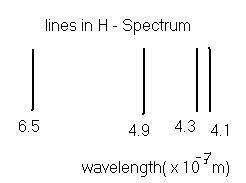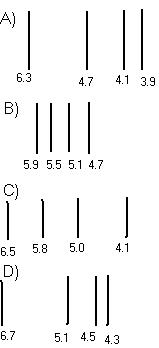Akshay's correct. Answer is D). Doppler effect is applicable in this case.
ADDED Q3)
Q1)
the plane of a dip circle is set in the geographical meridian and the apparent dip is θ1. It is then set in a vertical plane perpendicular to the geographic meridian. The apparent dip angle is θ2. The declination θ at the place is
A) θ = tan-1( tanθ1.tanθ2) B) θ = tan-1( tanθ1+tanθ2) C) \theta = tan^{-1}\left(\frac{tan\theta _{1}}{tan\theta _{2}} \right)
D) θ = tan-1( tanθ1 - tanθ2)
Q2)
two persons , A and B, stand at a distance x away frm each other in an open field. Wind blows frm A to B with a velocity ' w '.
i) A has a drum and sound travels frm A to B in t1 seconds.
ii) Now B has the drum and sound travels frm B to A in t2 seconds.
the velocity of sound in still air is :
A) 2x(t1+t2) B) \frac{x}{2}\left[\frac{1}{t_{1}}+\frac{1}{t_{2}} \right] C) \frac{wx}{2}\left[\frac{1}{t_{1}}+\frac{1}{t_{2}} \right] D) 2wx(t1+t2)
-
UP 0 DOWN 0 0 18

18 Answers
Yaar even I think Akshay is right...a star moving away provides a red shift. Doppler's effect in light has to be applied somehow..
Define "special" abhirup. lol..
Q1. All I know is that there is a relation
cot²∂1 + cot²∂2 = cot²∂
Now how you're going to get the answer from that, I have no idea...
so d shud b answer, now v hv 2 think of a valid reason
my reason is using refractive index, refractive index decreasin so wavelngth must increase.
n akshay bhaiya sayin abt doppler effect, as it is goin away, its frequency decreases so wavelenth must increase..but as far as i read, doppler effect is not valid for spacial things...
tabh valid reason kya hoga?
@ Abhirup
maybe u r correct,but then wat is the use of the fact that star is going away??
i jst want 2 confirm my way of thinking frm akshay bhaiya first....n akshay bhaiya, doppler effect is not applicable for cosmic particles...so how r u puttin it 4 the star thing?
@ Abhirup
ya but then wat is the use of the fact that the star is going away
I am sure Doppler's effect has to be used here
cant v thing of using refractive index...n laboratory is certainly denser than the outer space....
so refractive index is lower in the outer space...so the wavelength must increase
velo of air from A to B=v+w
so t1=xv+w
velo of air from B to A=v-w
t2=xv-w
use this reln to gwt b) as ans
Doppler's effect
appearent frequency would decrease and wavelength increase
But is the Doppler's effect applicable to Hydrogen Spectrum??
can u explain how...............
I culdn't thnk of anythng when i saw this problem [2]
Q3)
The four line Balmer series spectrum shown below is emitted by a hydrogen sample in a laboratory. A star moving away frm Earth also emits a hydrogen spectrum.
WHICH spectrum might be observed on Earth for this star ?
IN abv options wavelngth ( x 10 -7 m)